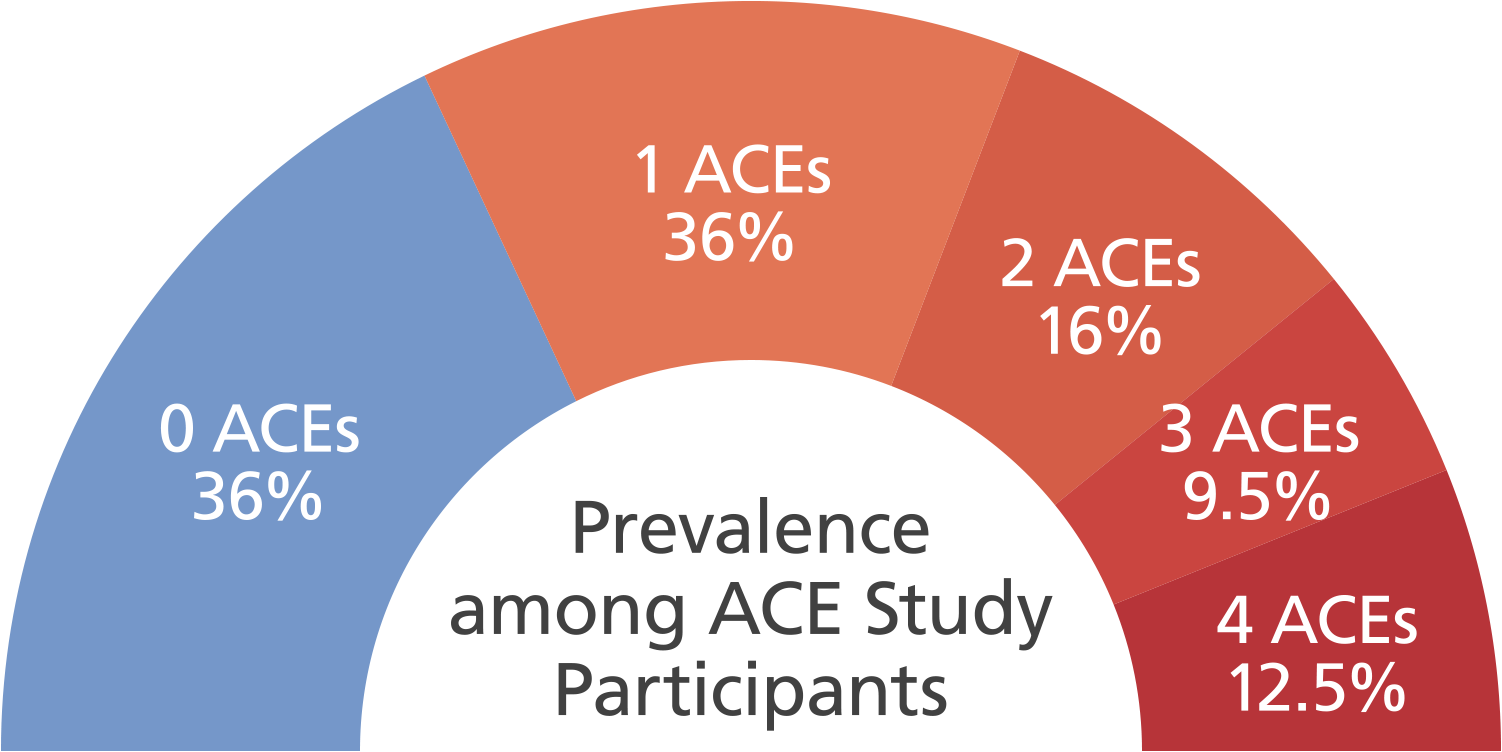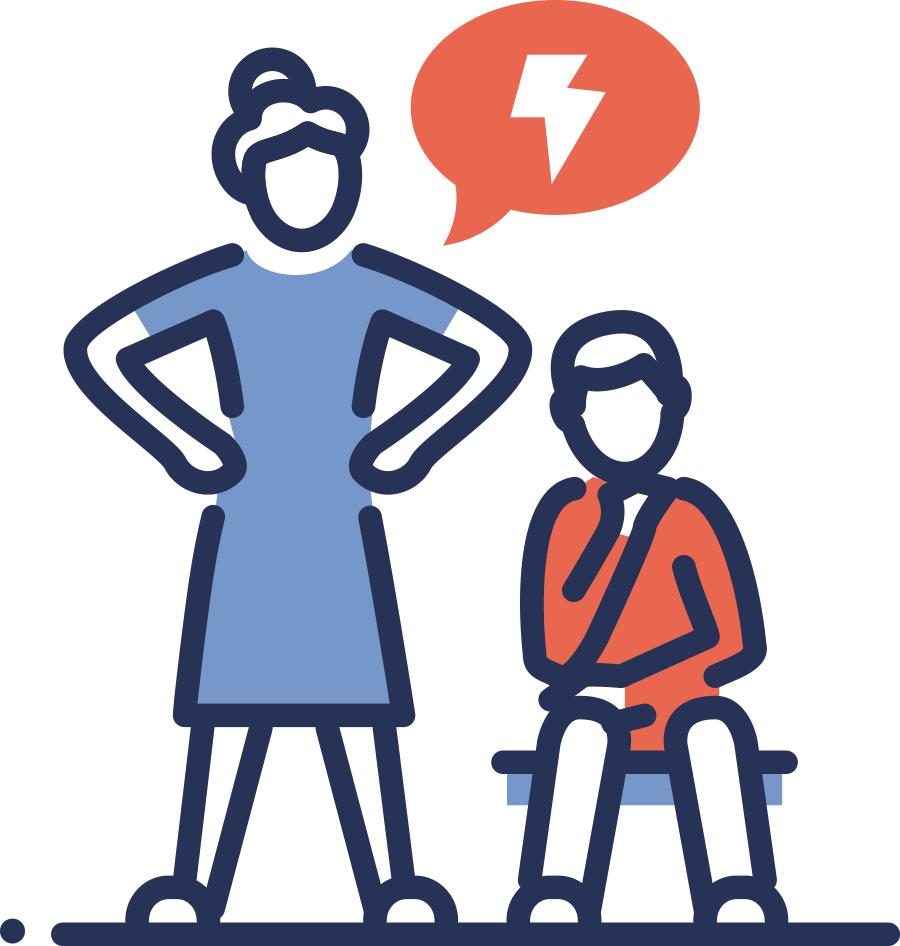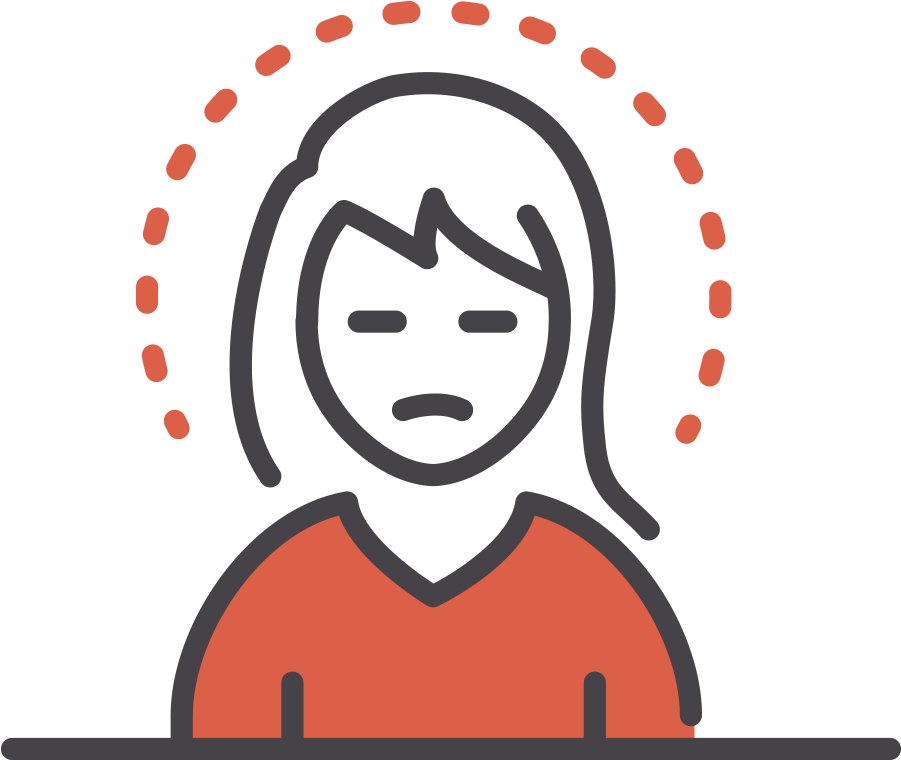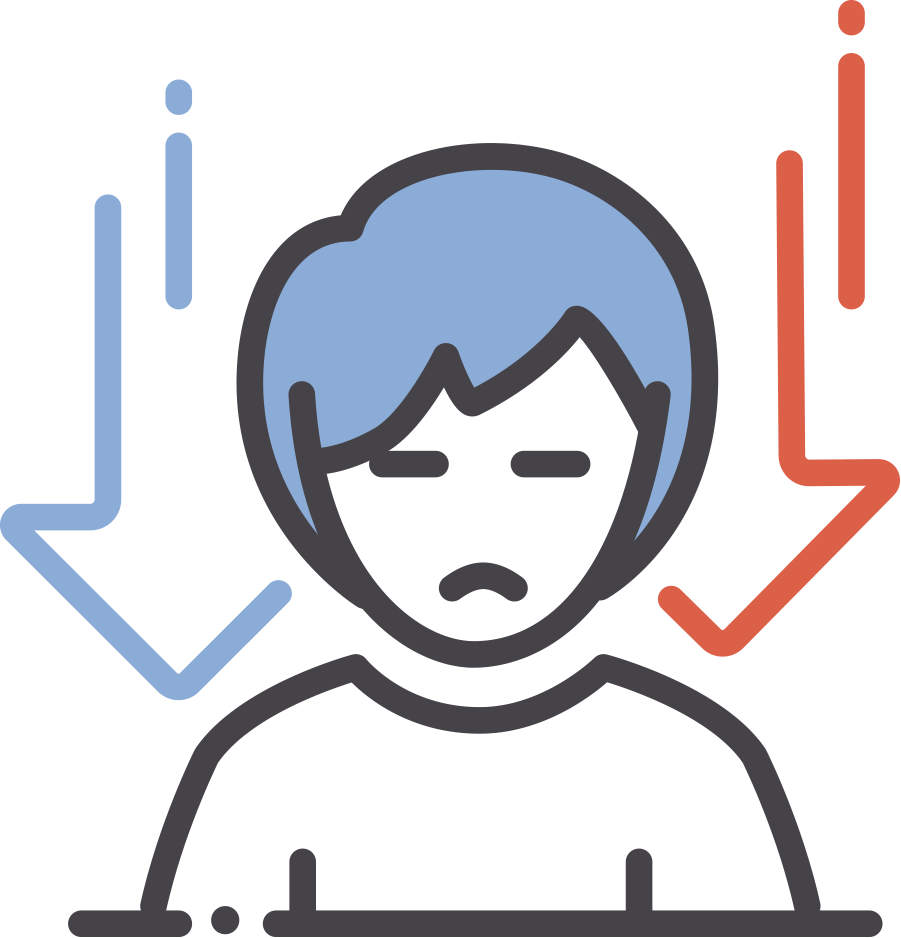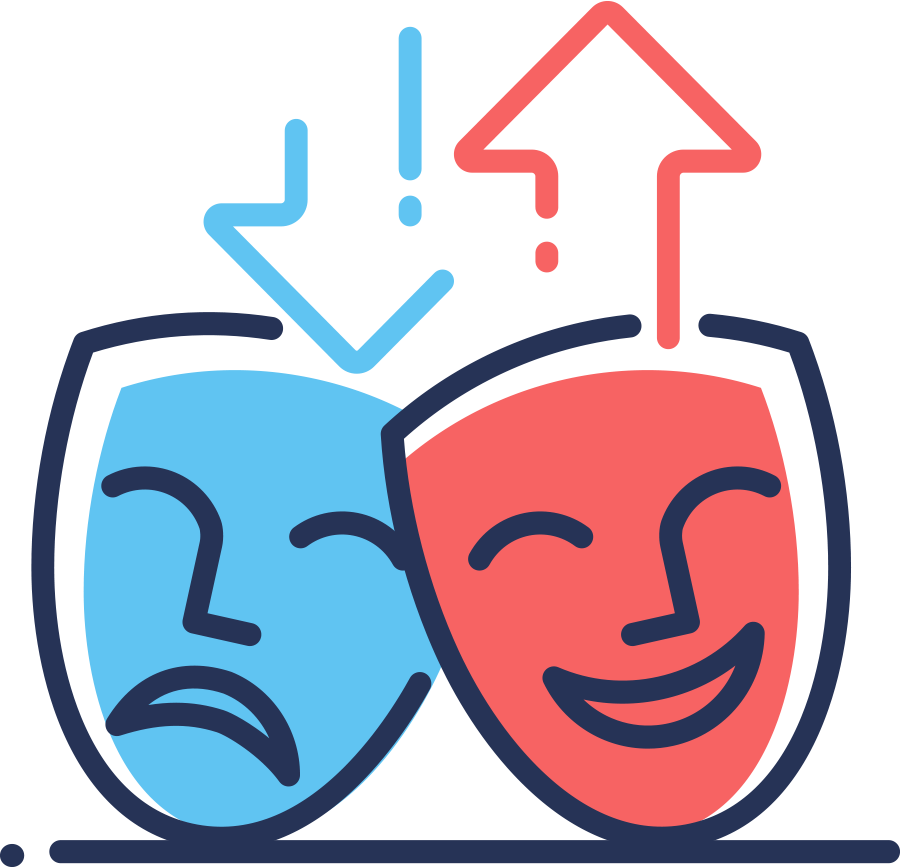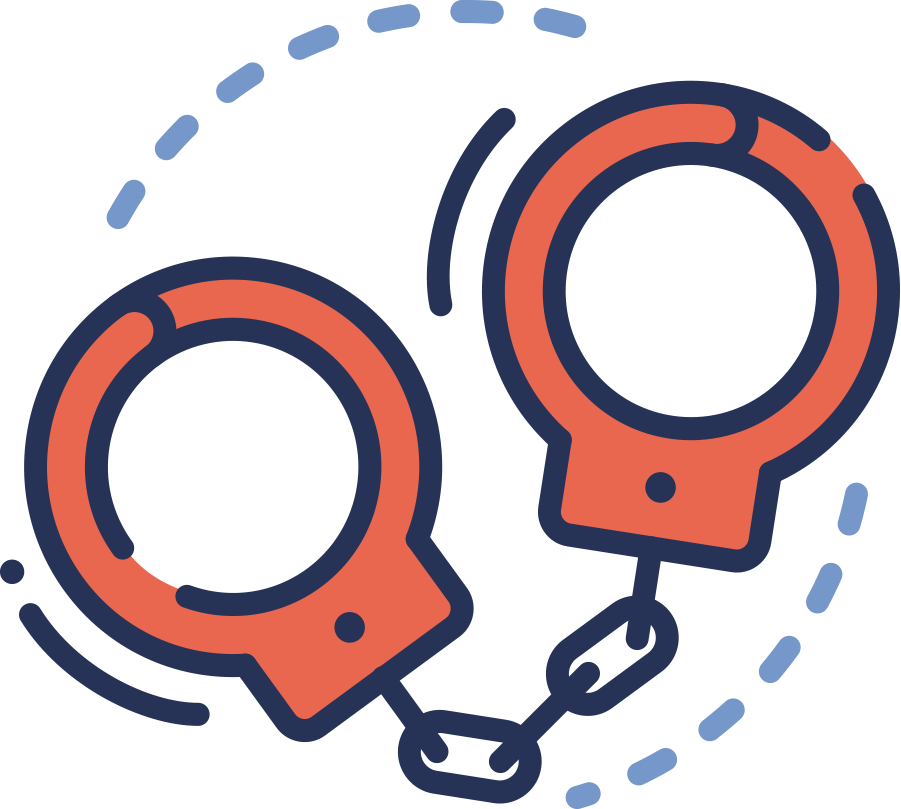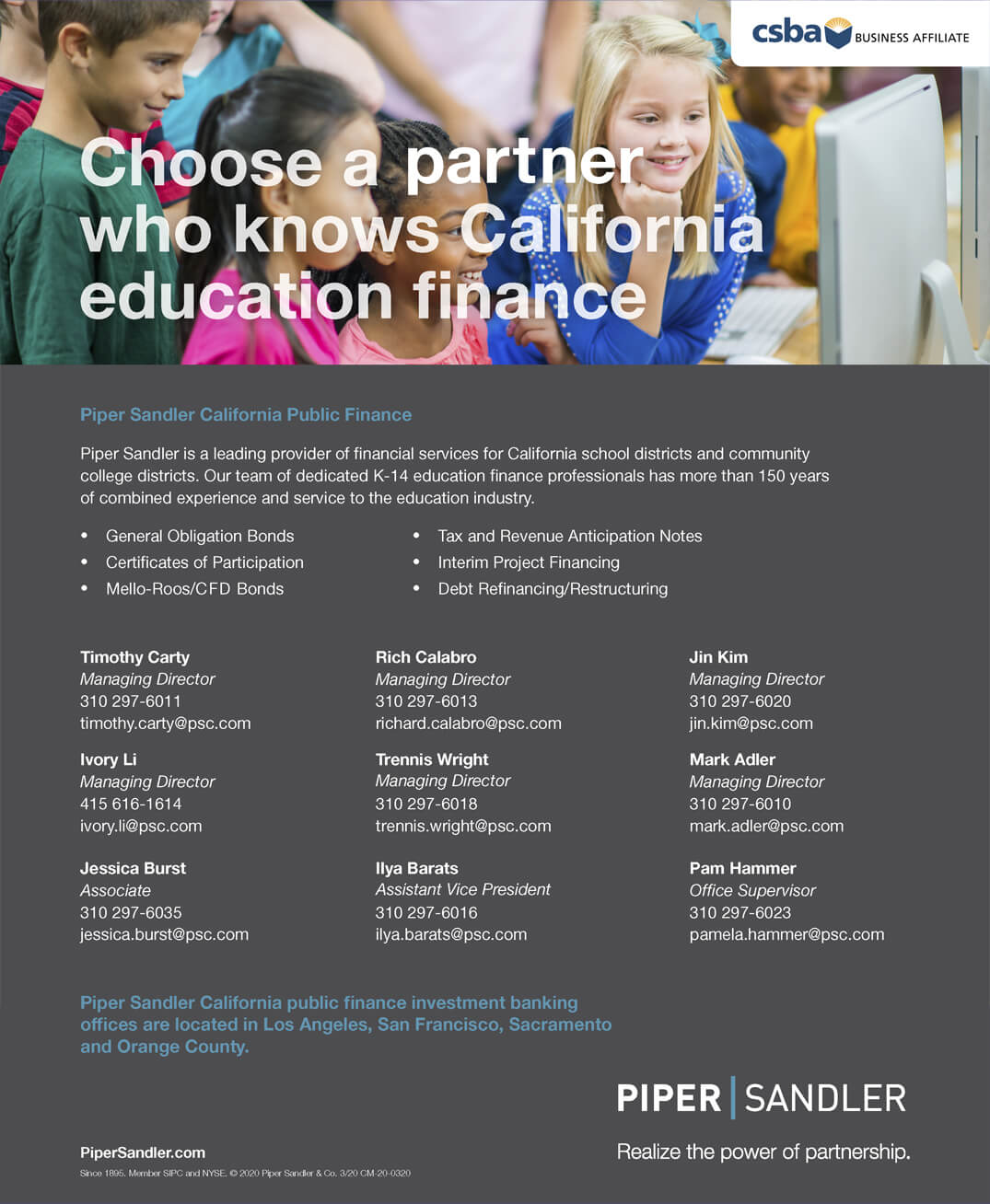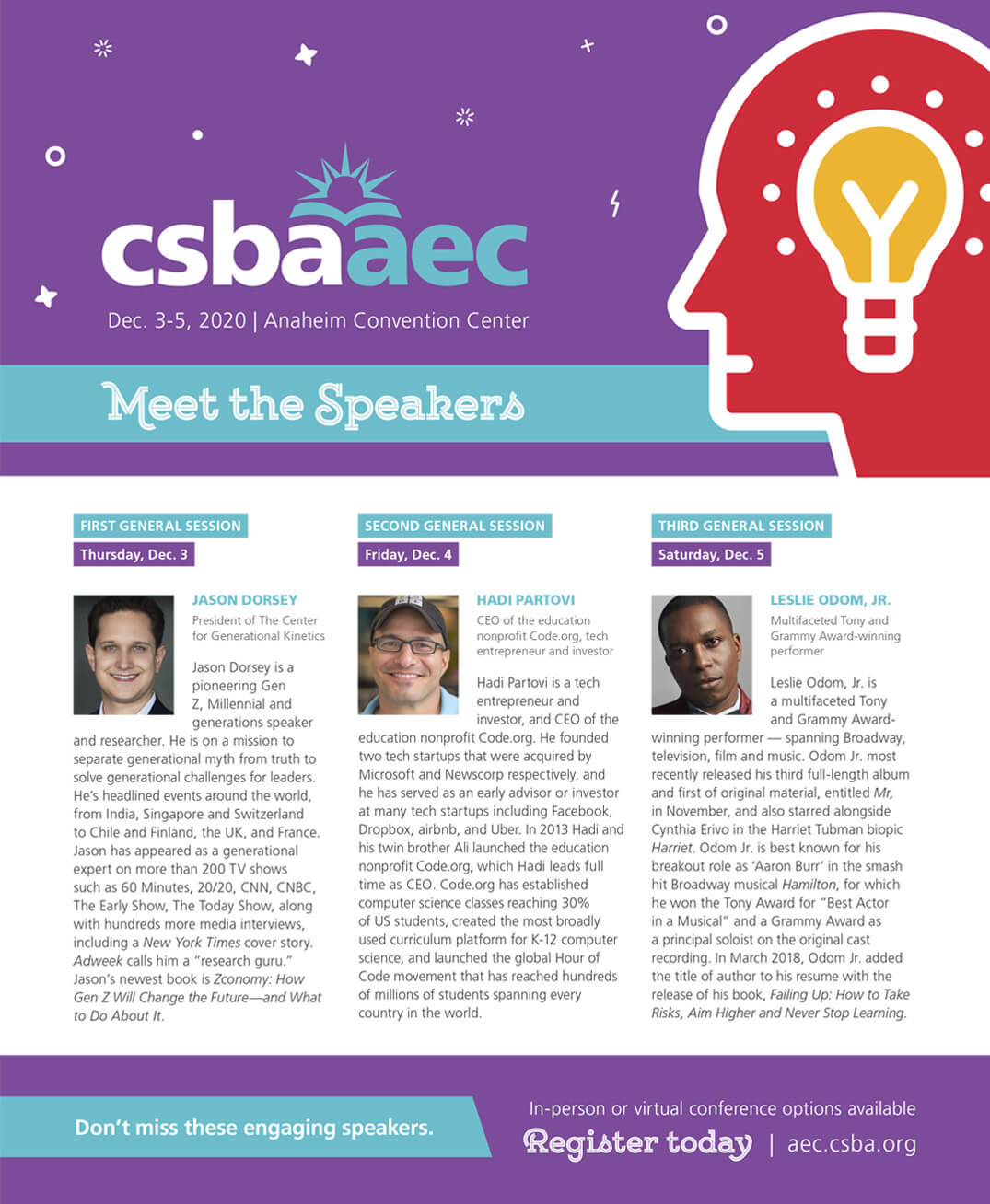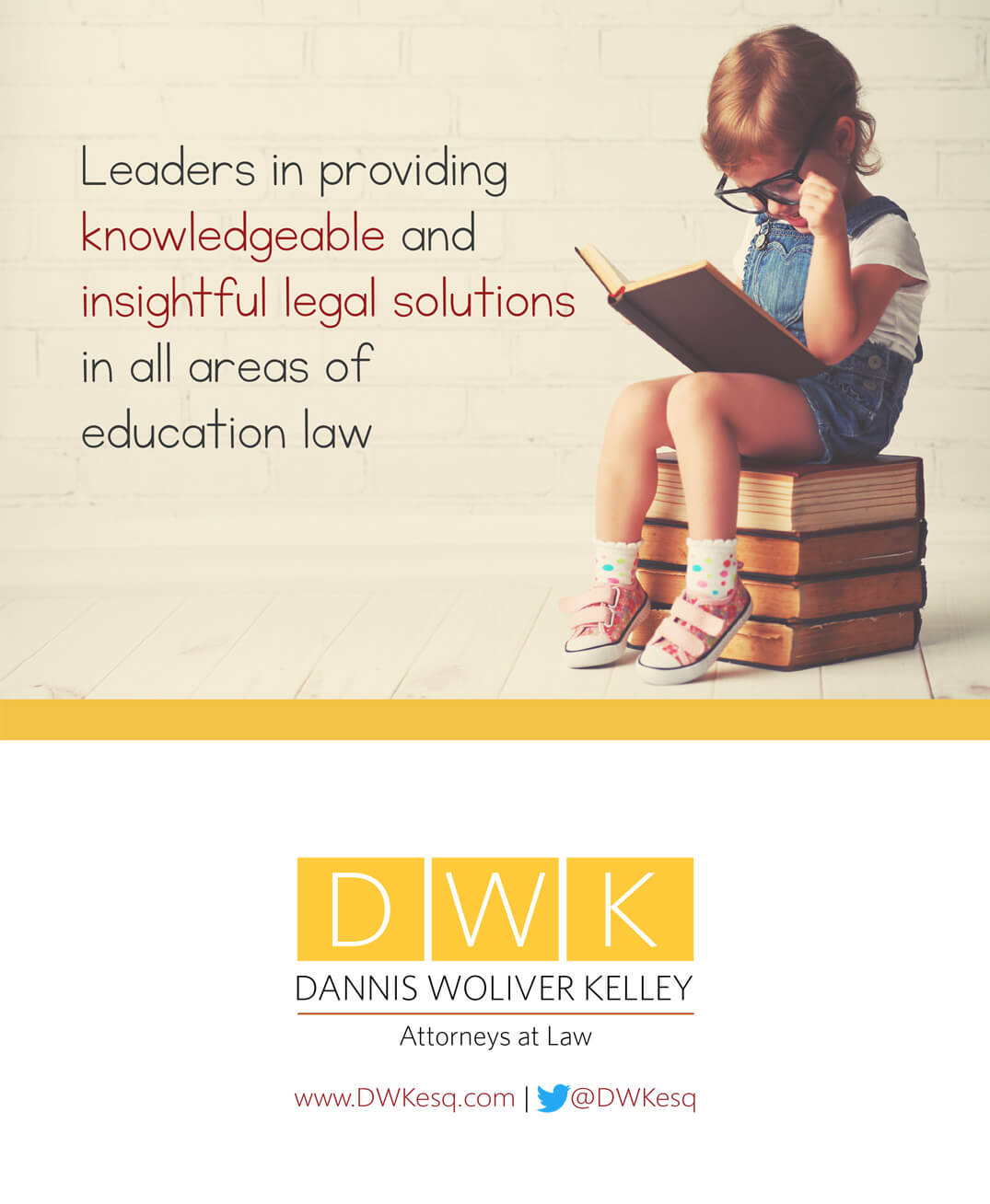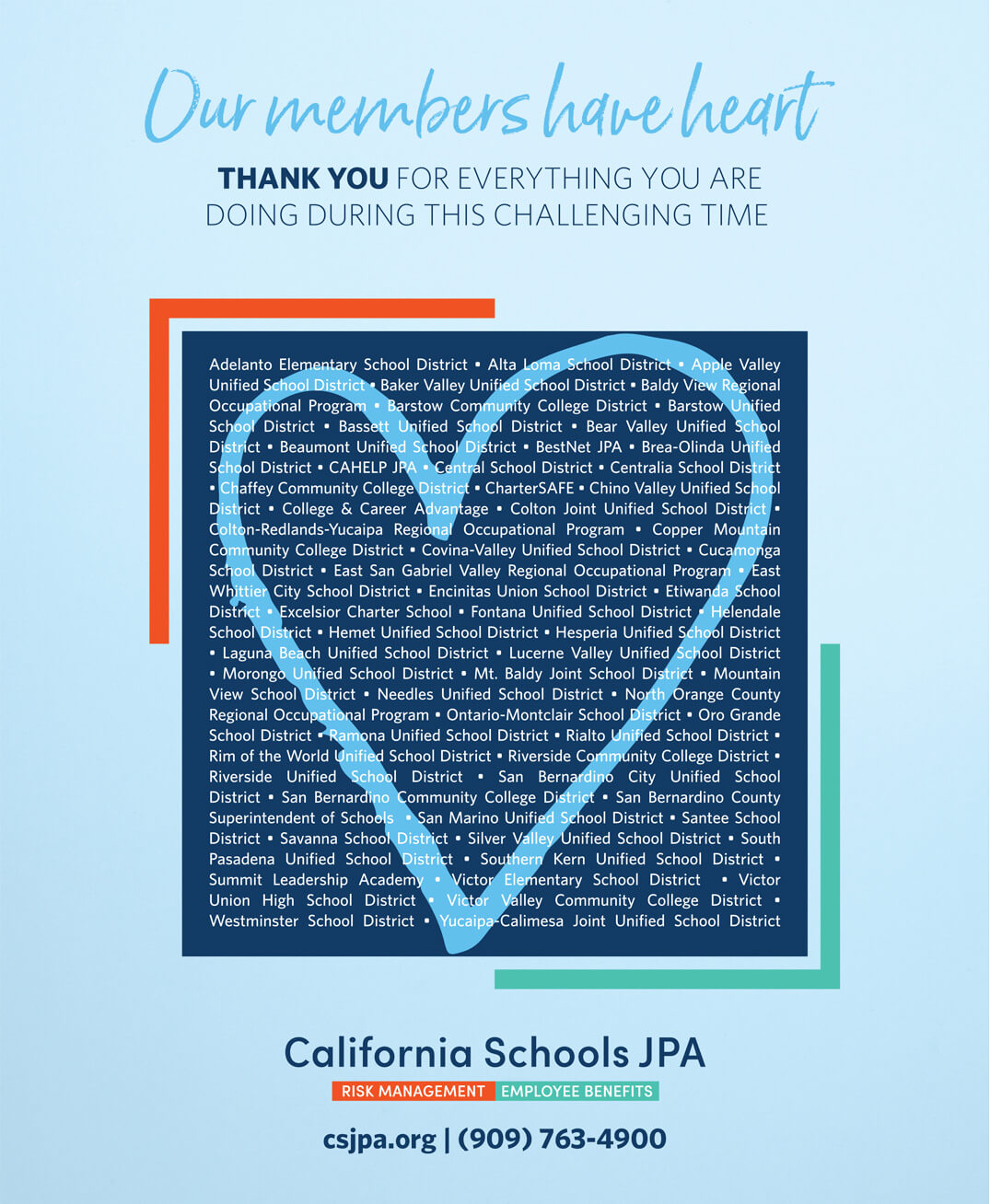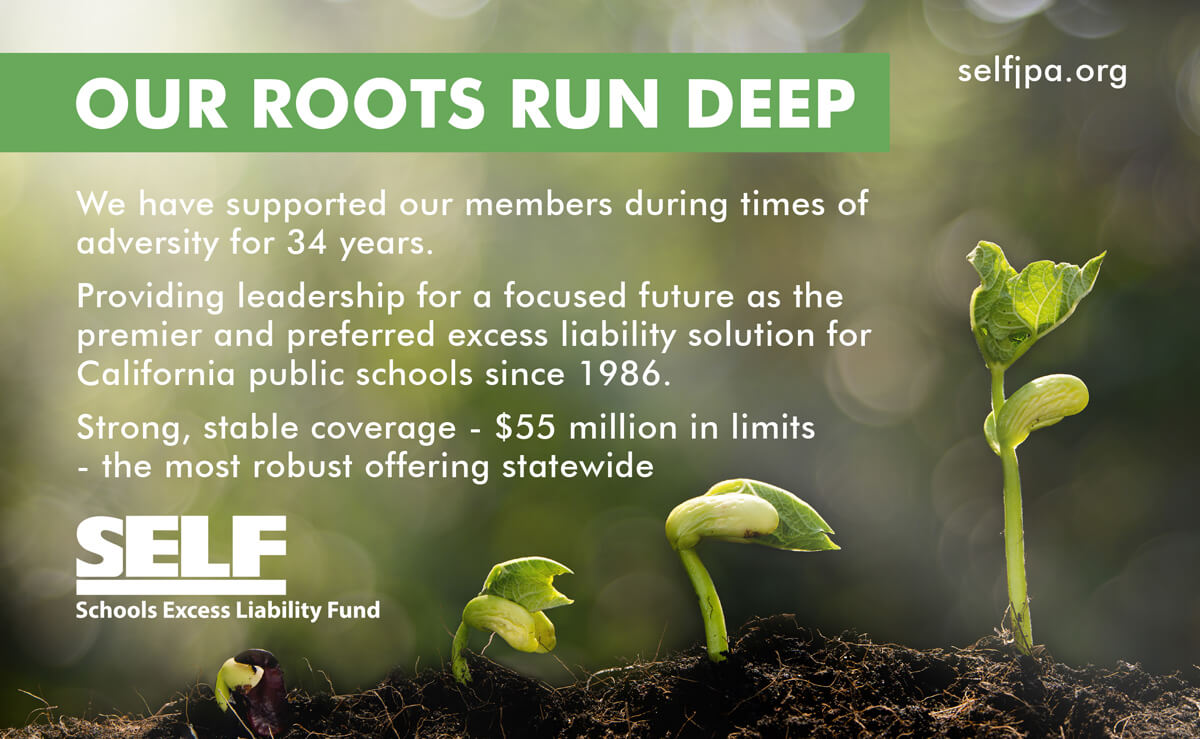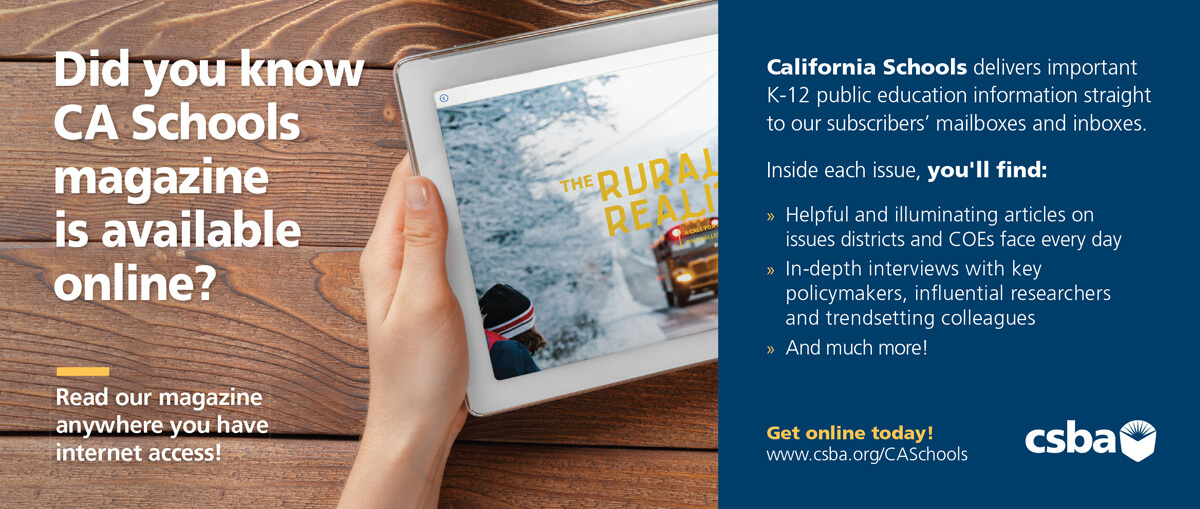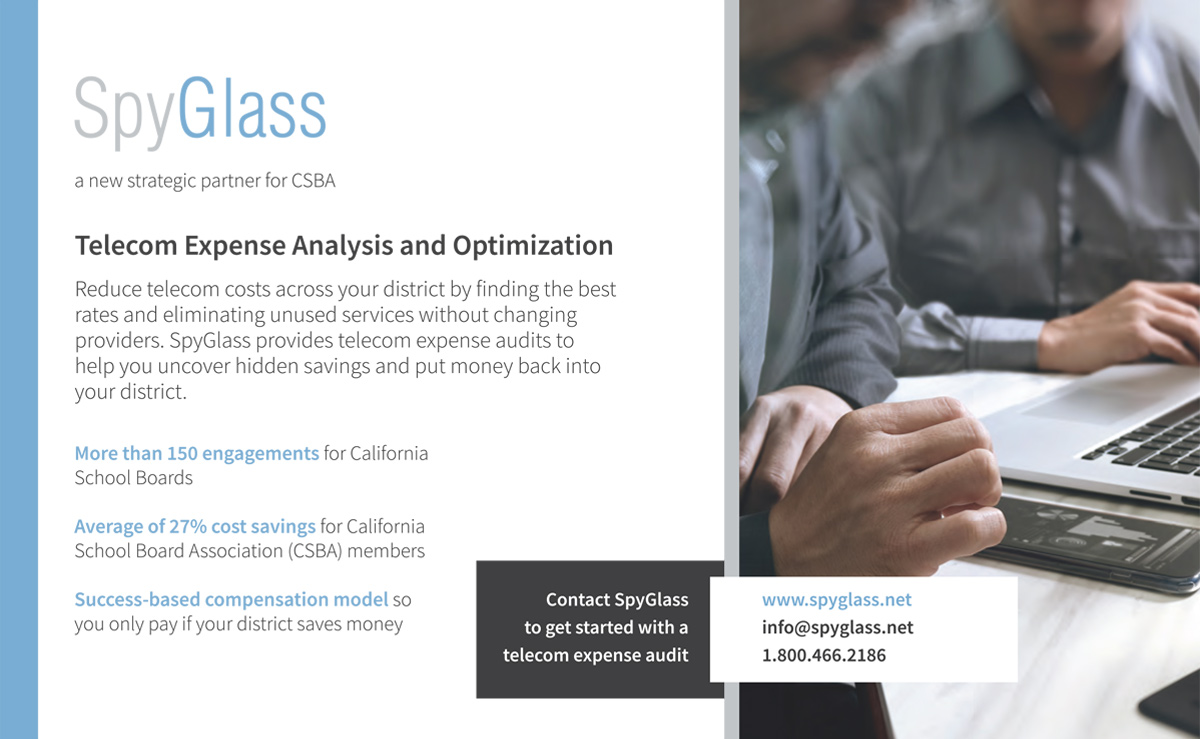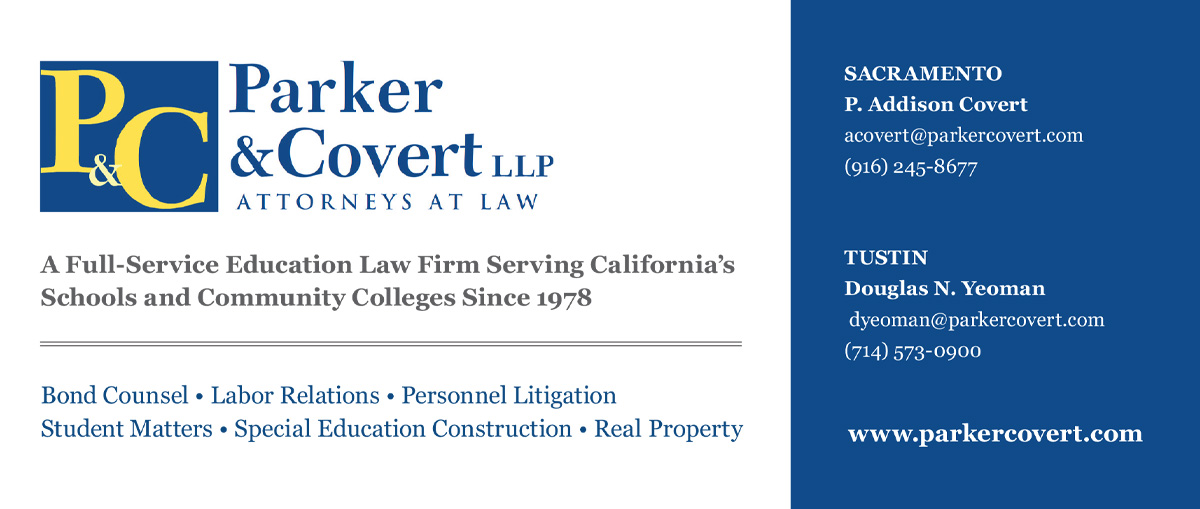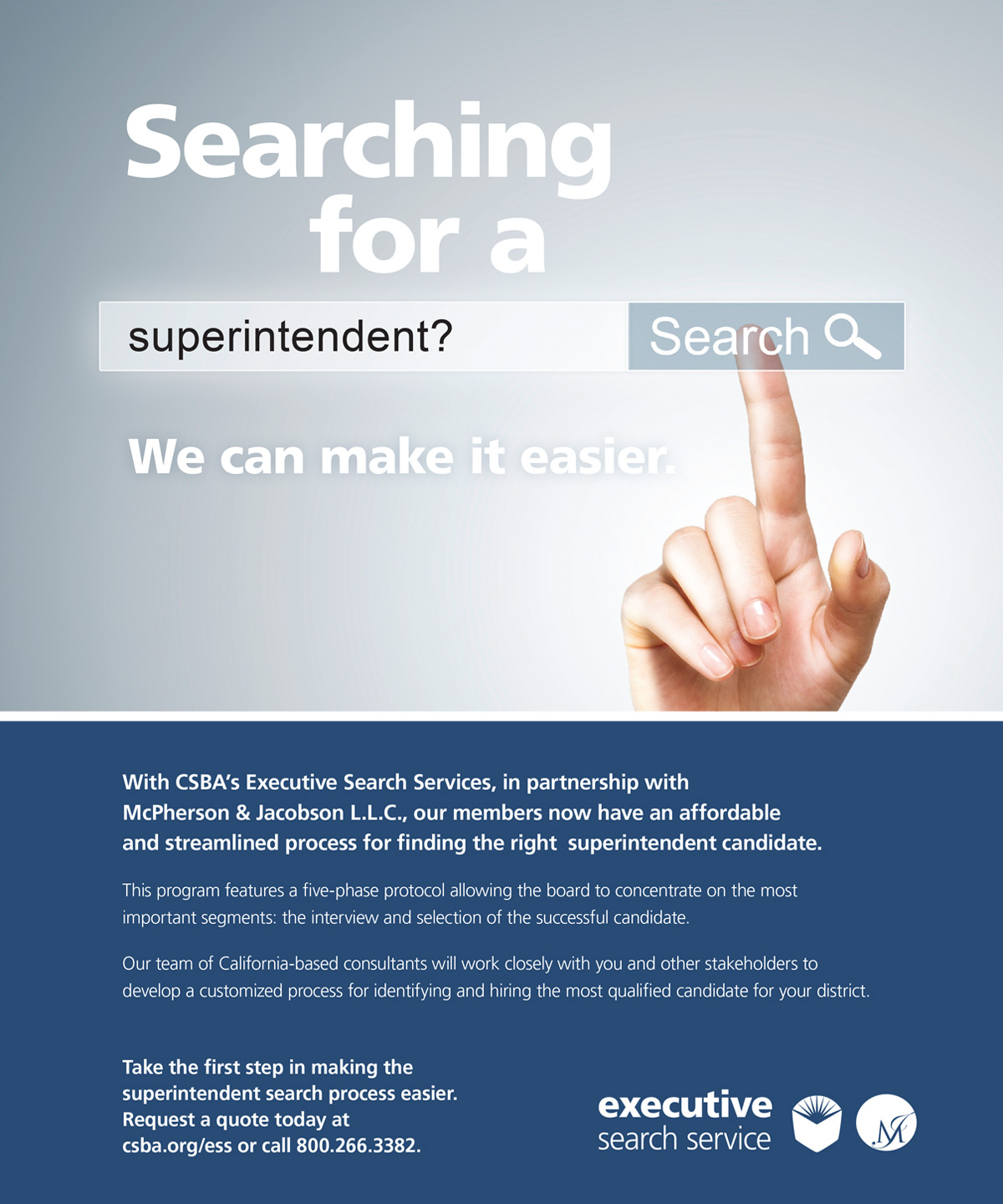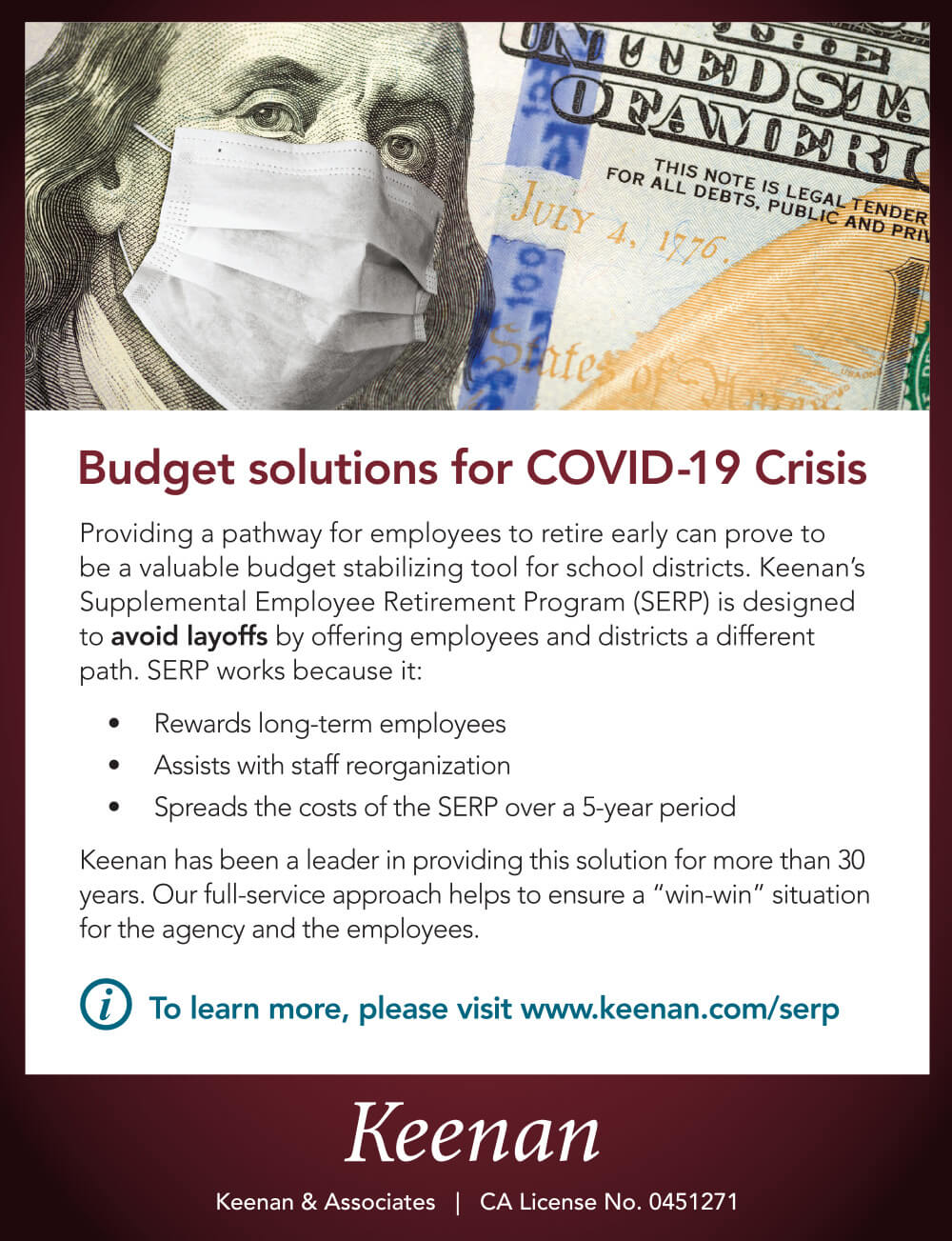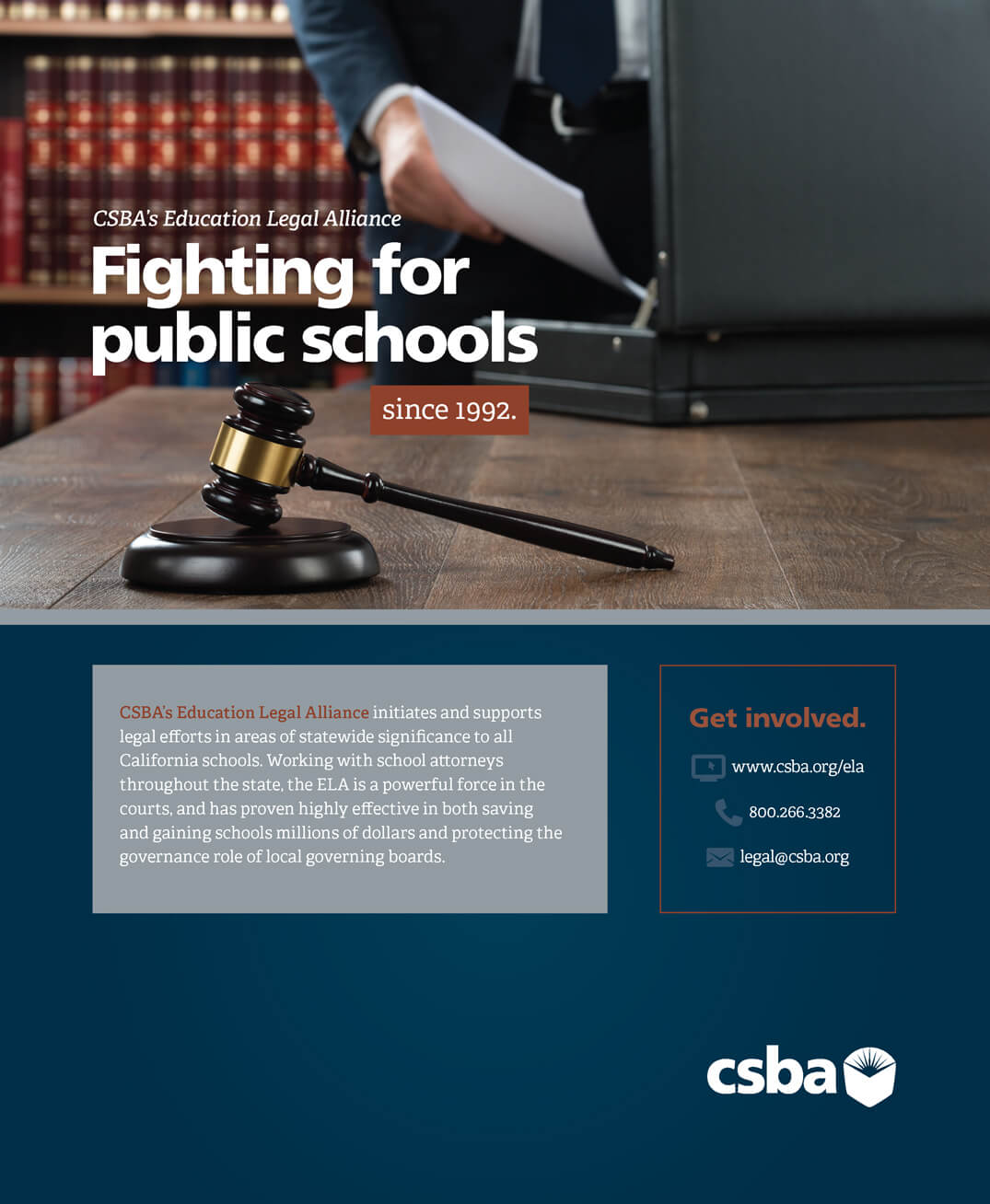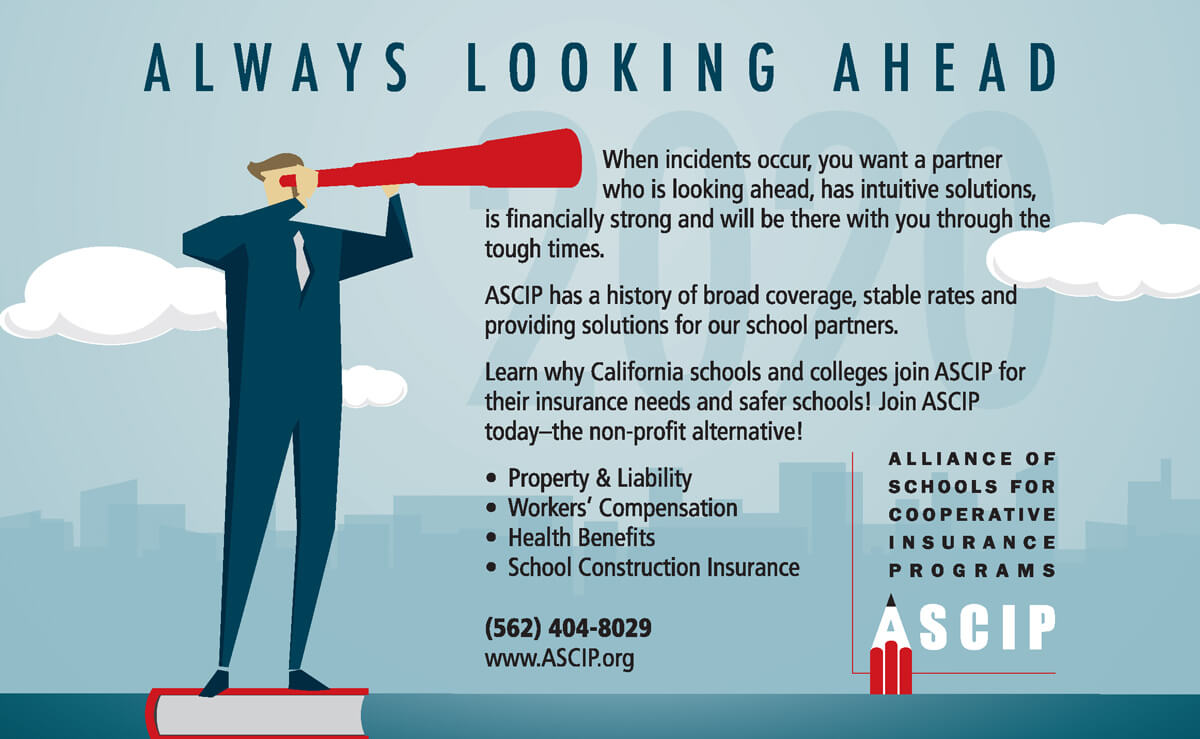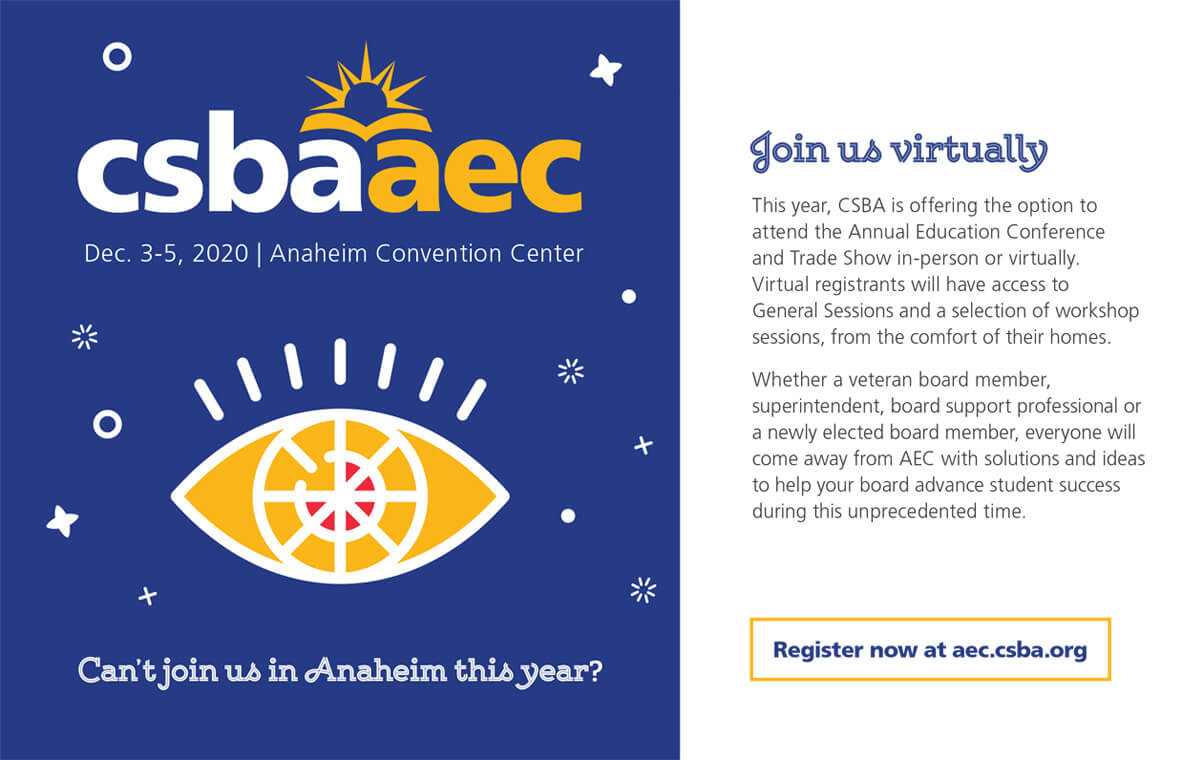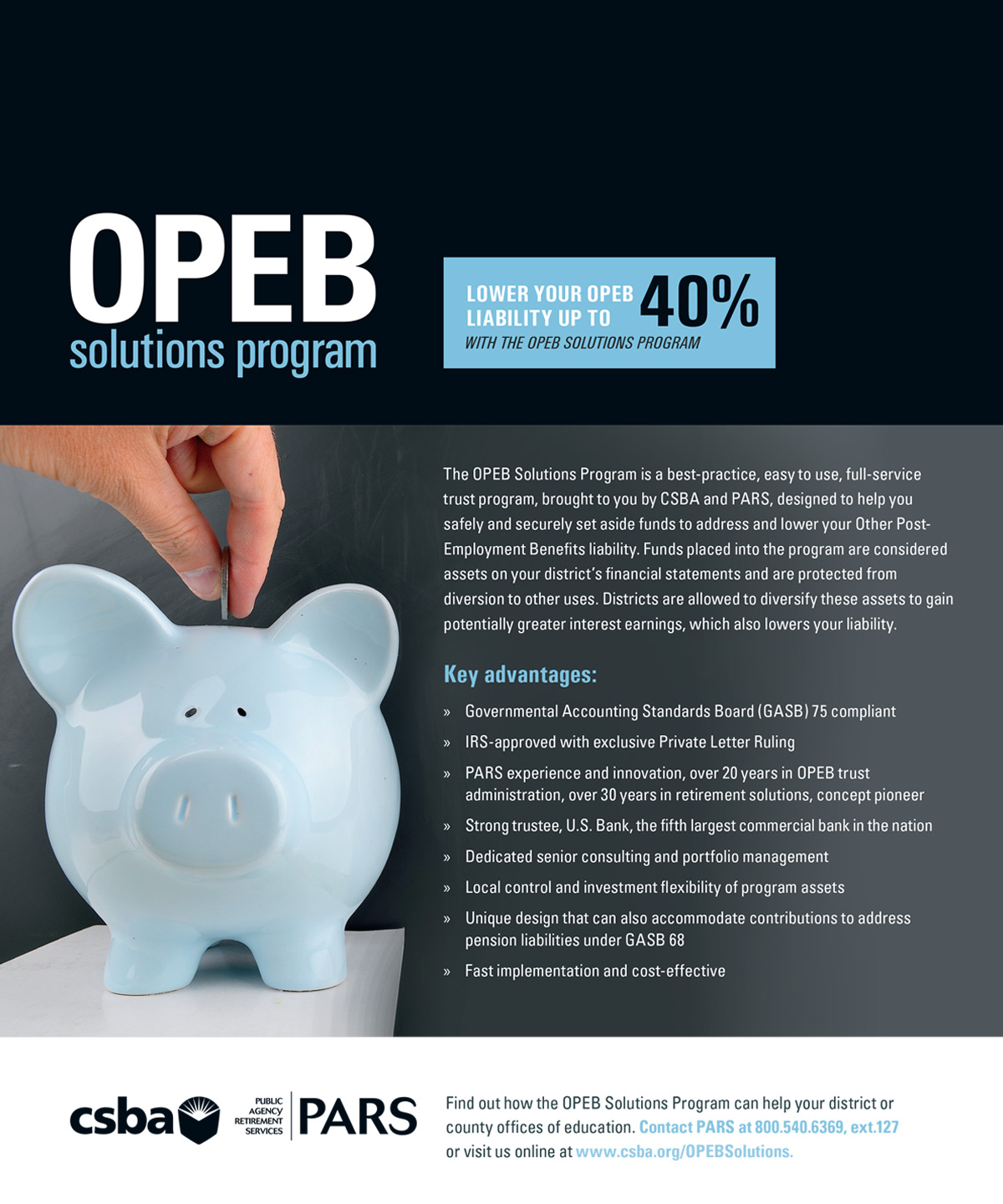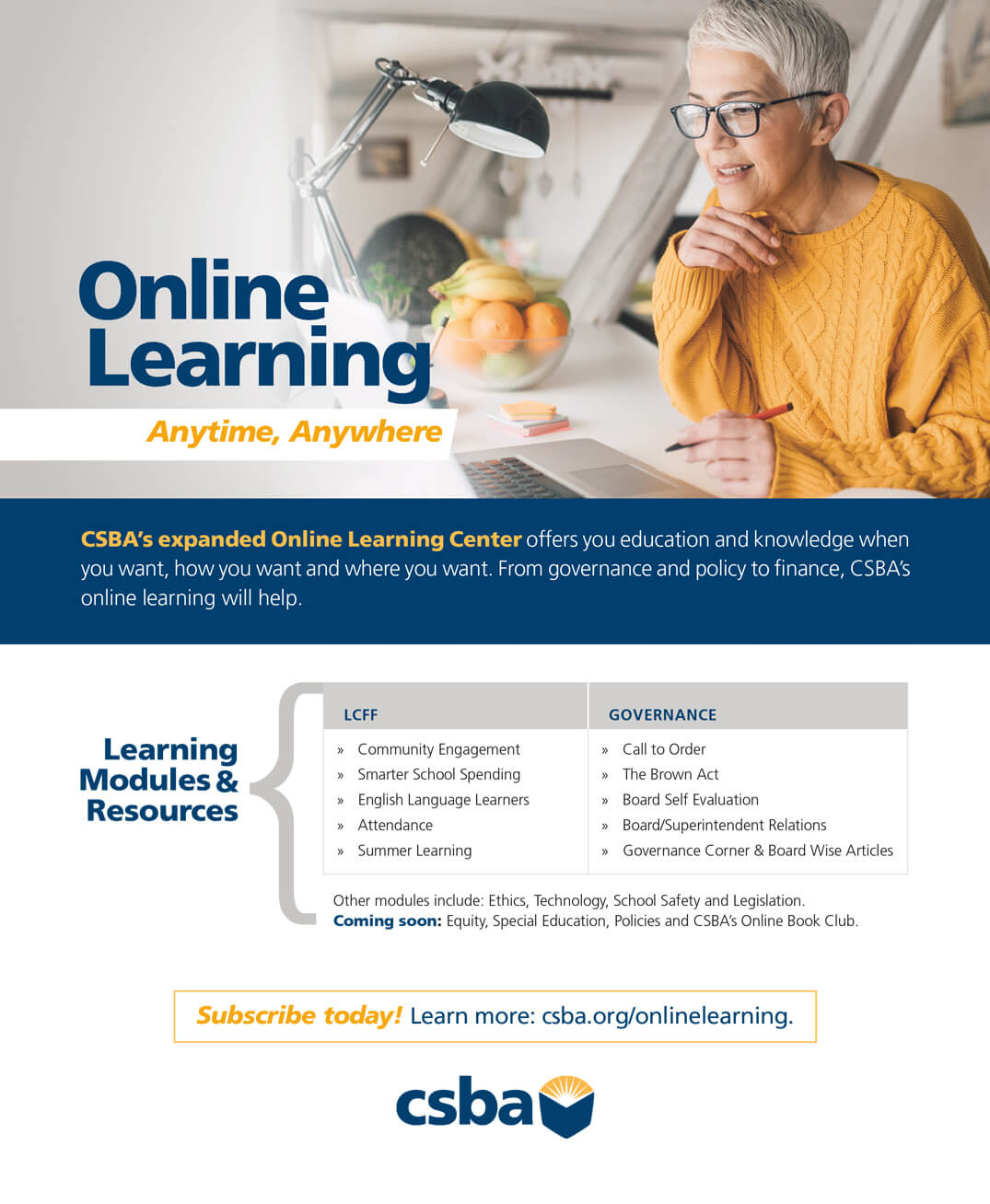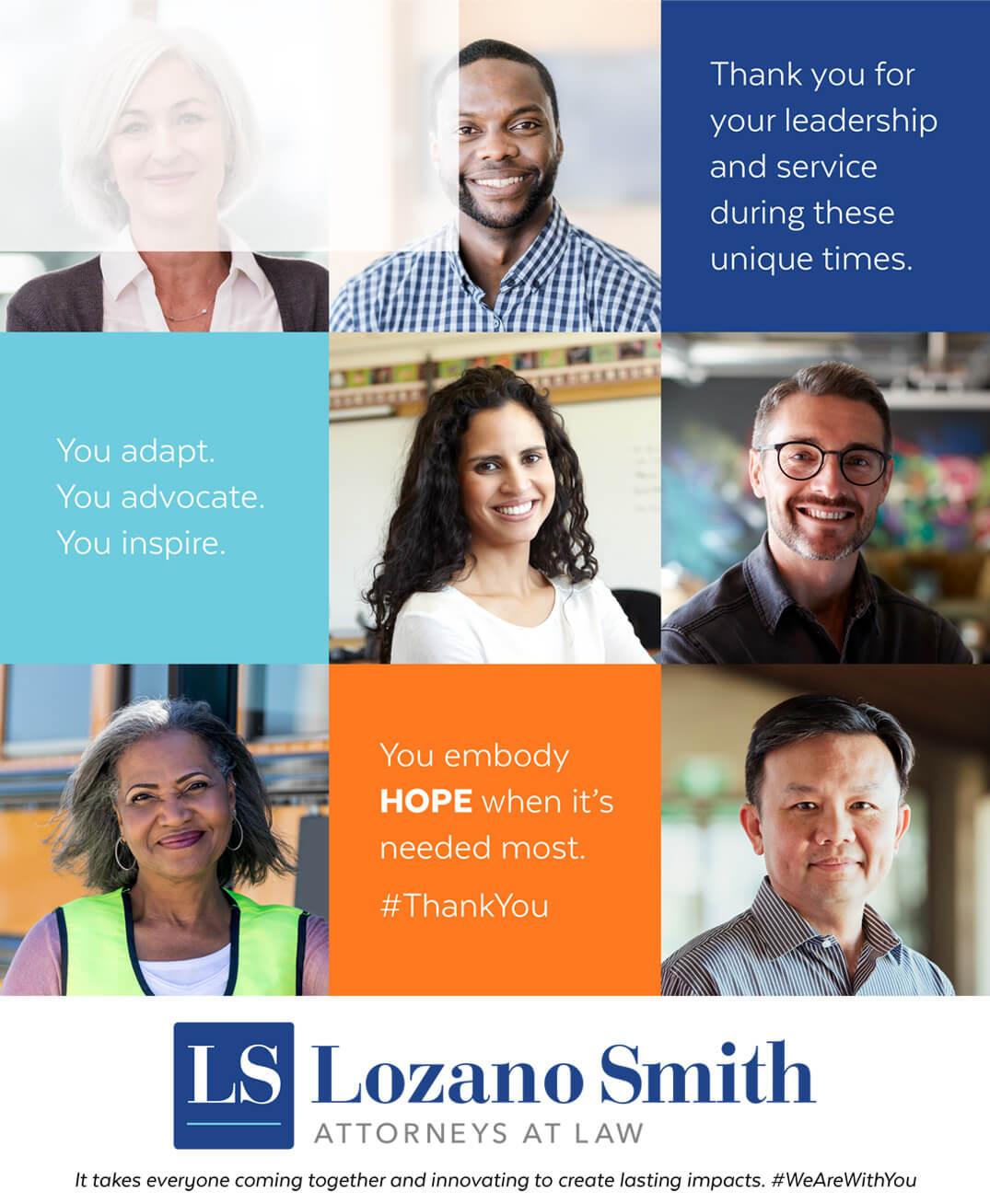
Summer 2020
Spotlighting district successes during the COVID-19 pandemic
by Kimberly Sellery
The reinvigorated effort to identify and serve homeless students
by Andrew Cummins
by Vernon M. Billy
by Kathryn Meola
by Teri Vigil, Deb Dudley and Lynn Bogart
by Christina Maharani Rajlal
by Kimberly Sellery
Interview with Cindy Gardner
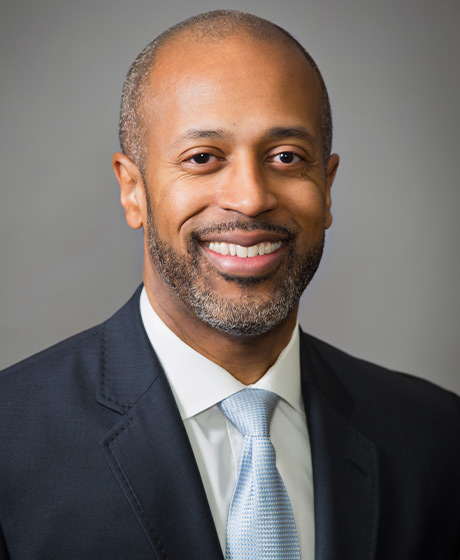
During the embryonic years of the United States, a debate raged amongst the intellectual elite and ordinary people about how our would-be nation should be structured and governed. Only a few years after successfully repelling the British Redcoats and delivering a stunning defeat to England — one of the most powerful countries in the world at the time — the new leaders of these United States (actually, a confederation of states) vigorously debated the future governance of our young country.

Region 1, Del Norte County US
Sherry Crawford
Region 2, Siskiyou COE
A.C. “Tony” Ubalde, Jr.
Region 3, Vallejo City USD
Paige Stauss
Region 4, Roseville Joint Union HSD
Alisa MacAvoy
Region 5, Redwood City ESD
Darrel Woo
Region 6, Sacramento City USD
Yolanda Peña Mendrek
Region 7, Liberty Union HSD
Region 8, Lammersville Joint USD
Tami Gunther
Region 9, Atascadero USD
Susan Markarian
Region 10, Pacific Union ESD
Jackie Moran
Region 11, Ventura ESD
William Farris
Region 12, Sierra Sands USD
Meg Cutuli
Region 15, Los Alamitos USD
Karen Gray
Region 16, Silver Valley USD
Region 17, Solana Beach SD
Wendy Jonathan
Region 18, Desert Sands USD
Albert Gonzalez
Region 20, Santa Clara USD
Scott Schmerelson
Region 21, Los Angeles USD
Nancy Smith
Region 22, Palmdale SD
Helen Hall
Region 23, Walnut Valley USD
Donald E. LaPlante
Region 24, Downey USD
Director-at-Large African American,
Monterey Peninsula USD
Crystal Martinez-Alire
Director-at-Large American Indian,
Elk Grove USD
Gino Kwok
Director-at-Large Asian/Pacific Islander,
Hacienda La Puente USD
Bruce Dennis
Director-at-Large County, Riverside COE
Joaquín Rivera
Director-at-Large Hispanic, Alameda COE
Janet Wohlgemuth
CCBE President, Monterey COE
Region 1, Del Norte County US
Sherry Crawford
Region 2, Siskiyou COE
A.C. “Tony” Ubalde, Jr.
Region 3, Vallejo City USD
Paige Stauss
Region 4, Roseville Joint Union HSD
Alisa MacAvoy
Region 5, Redwood City ESD
Darrel Woo
Region 6, Sacramento City USD
Yolanda Peña Mendrek
Region 7, Liberty Union HSD
Matthew Balzarini
Region 8, Lammersville Joint USD
Tami Gunther
Region 9, Atascadero USD
Susan Markarian
Region 10, Pacific Union ESD
Jackie Moran
Region 11, Ventura ESD
William Farris
Region 12, Sierra Sands USD
Meg Cutuli
Region 15, Los Alamitos USD
Karen Gray
Region 16, Silver Valley USD
Debra Schade
Region 17, Solana Beach SD
Wendy Jonathan
Region 18, Desert Sands USD
Albert Gonzalez
Region 20, Santa Clara USD
Scott Schmerelson
Region 21, Los Angeles USD
Nancy Smith
Region 22, Palmdale SD
Helen Hall
Region 23, Walnut Valley USD
Donald E. LaPlante
Region 24, Downey USD
Bettye Lusk
Director-at-Large African American,
Monterey Peninsula USD
Crystal Martinez-Alire
Director-at-Large American Indian,
Elk Grove USD
Gino Kwok
Director-at-Large Asian/Pacific Islander,
Hacienda La Puente USD
Bruce Dennis
Director-at-Large County, Riverside COE
Joaquín Rivera
Director-at-Large Hispanic, Alameda COE
Janet Wohlgemuth
CCBE President, Monterey COE
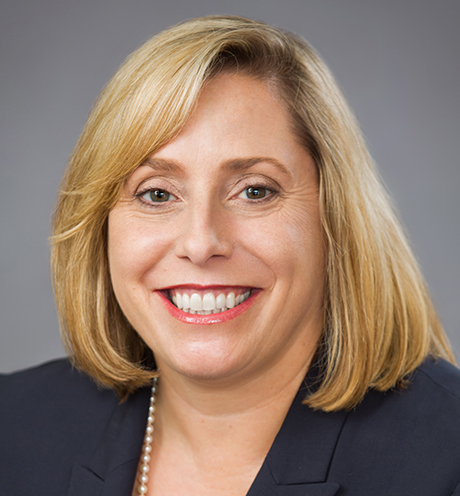
o answer this question, we have to look at what it means to provide Free Appropriate Public Education (FAPE) before COVID-19-related school closures and distance learning. Under the Individuals with Disabilities Education Act, students with disabilities are entitled to an educational program that is individualized to each specific child’s unique needs, and from which the child receives educational benefit.
FAPE means special education and related services are provided at public expense, under public supervision and direction and without charge, in conformity with the individualized education program. Special education is defined as specially designed instruction, provided at no cost to parents or guardians, to meet the unique needs of a child with a disability, including classroom instruction, instruction in physical education, home instruction, and instruction in hospitals and institutions. Related services are transportation and such developmental, corrective and other supportive services as may be required to assist a child with a disability to benefit from special education.

Chief Information Officer
Troy Flint, tflint@csba.org
Managing Editor
Kimberly Sellery, ksellery@csba.org
Marketing Director
Serina Pruitt, spruitt@csba.org
Staff Writers
Andrew Cummins, acummins@csba.org
Alisha Kirby, akirby@csba.org
Graphic Design Manager
Kerry Macklin, kmacklin@csba.org
Senior Graphic Designer
Mauricio Miranda, mmiranda@csba.org
Circulation and Advertising
csba@csba.org
Xilonin Cruz-Gonzalez, Azusa USD
President-elect
Suzanne Kitchens, Pleasant Valley SD
Vice President
Dr. Susan Heredia, Natomas USD
Immediate Past President
Dr. Emma Turner, La Mesa-Spring Valley SD
CEO & Executive Director
Vernon M. Billy
California Schools (ISSN 1081-8936) is published quarterly by the California School Boards Association, Inc., 3251 Beacon Boulevard, West Sacramento, CA 95691, (916) 371-4691. $2 of CSBA membership dues goes toward the subscription to California Schools magazine for each board member and superintendent. The subscription rate for each CSBA nonmember is $20. Periodicals postage paid at West Sacramento, CA and at additional mailing office. Postmaster: Send address changes to California Schools, 3251 Beacon Blvd., West Sacramento, CA 95691.
Articles submitted to California Schools are edited for style, content and space prior to publication. Views expressed are those of the authors and do not necessarily represent CSBA policies or positions. Articles may not be reproduced without written permission of the publisher. Endorsement by CSBA of products and services advertised in California Schools is not implied or expressed.

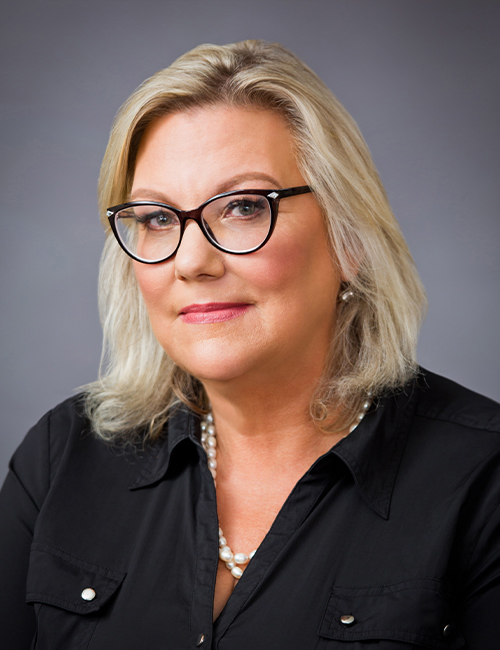
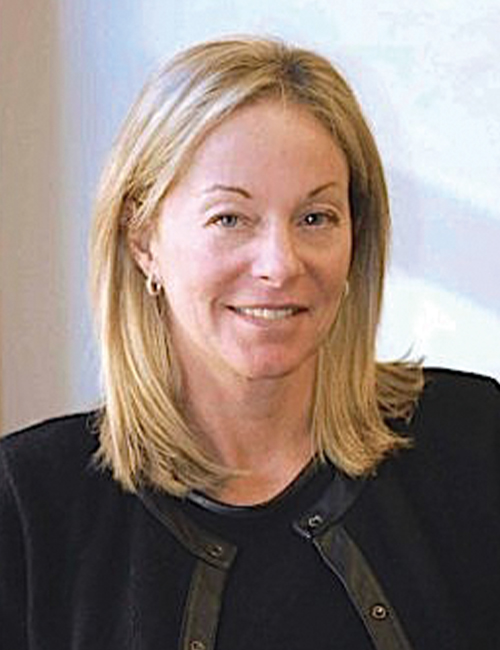
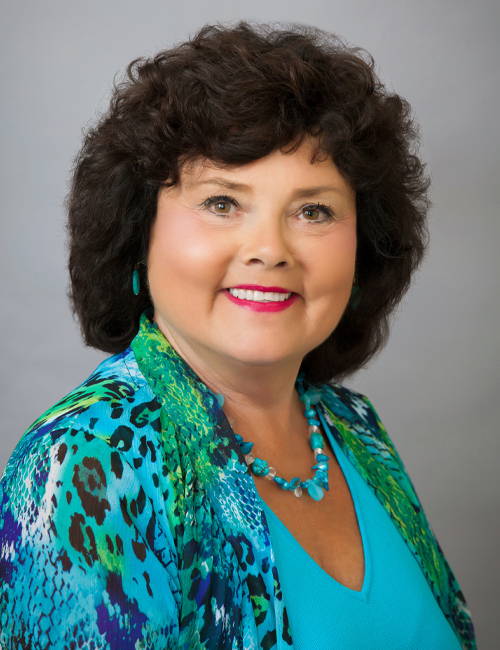
Dear Boardwise
How can our governance team develop board meeting agendas that would support student achievement?
class act: Best practices in action
class act:
Best practices in action

class act:
Best practices in action

School leadership created the Clubhouse to improve school culture and remove barriers to support services that ensure all students have what they need to succeed. The 2019 Golden Bell Award-winning program in eastern Los Angeles County brings all support staff in this preK-8 school under one roof to promote collaboration and cohesiveness in the services they provide.
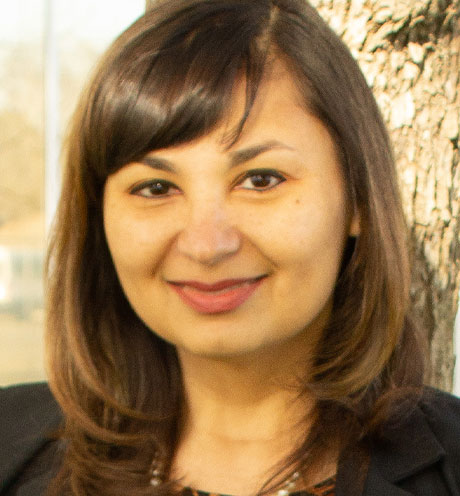
n the spring of 2019, Kern County’s Behavioral Health Department, known as Kern Behavioral Health and Recovery Services, was looking for more hands-on delivery of services to school-aged children that would help develop their social-emotional learning and enhance their resiliency. As the department started to look at enhancing services for at-risk and underrepresented youth, it saw an opportunity to provide services within the educational constructs in Kern County through the Mental Health Services Act, for Prevention and Early Intervention (PEI) services.
PEI services and programming promote wellness, foster health and prevent suffering that can result in untreated mental illness. PEI also requires that most services are provided to youth.

lementary school teachers from the Elk Grove Unified School District, in partnership with the Sacramento Area Science Project, gathered last summer for four days of intensive and interactive professional development around the California Next Generation Science Standards.
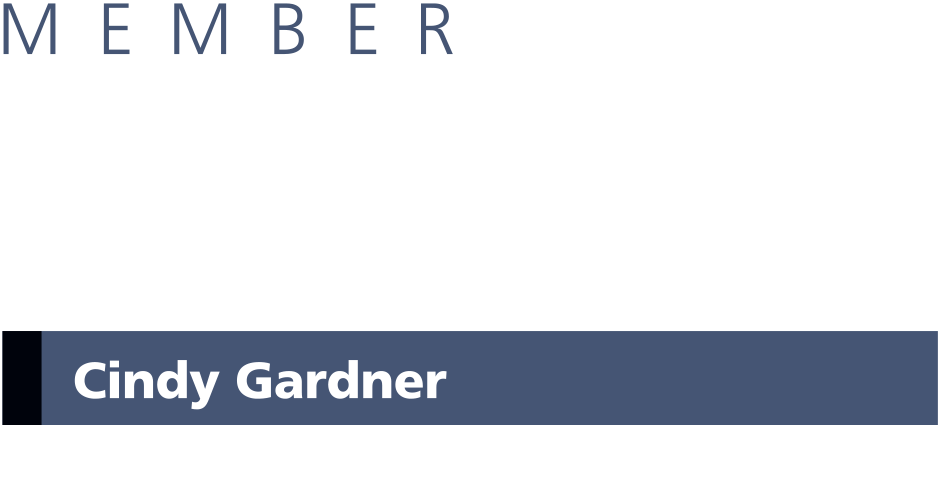
How long have you been a school board member and what inspired you to become one?
I have been a board member for eight years. I am a volunteer at heart who cannot say “no” when it comes to helping kids. I have been involved in PTA, school site councils, youth baseball and other organizations for years. A former school board member made me realize I could help our students on a higher level. I couldn’t say “no” to that.
What do you see as the role of public education?
I believe public education is the great equalizer and can change lives. Knowledge gained from a good education opens up possibilities for a child. My family was poor. I became the first in my family to go to college. My sisters followed suit, which inspired my mother to earn her nursing degree, which was her dream. Education changed our lives.
You spoke at the State Capitol on the negative impacts of the late start time bill, Senate Bill 328. How was that experience?
The experience was awe-inspiring. Walking into the hearing rooms, in front of a dais of state elected officials, was nerve racking. But it was so important for me to tell them our story of how the unintended consequences of the bill would hurt our district and students. I realized afterward that our legislators really need to hear our stories. I felt proud and humbled that I was asked to tell it.
Who was one of your favorite teachers and why?
My high school drama teacher, Doc Roberts. My family moved around a lot and by the time I reached high school, I had attended 13 different schools. As a result, I was shy. He pushed his students to take chances and created a “safe” environment for us to challenge ourselves. My self-esteem and self-confidence just exploded during my four years in his class.
What are some of the overlooked or underappreciated issues in rural districts like yours?
Geography, distance and weather make transportation really important in getting our students to school. However, transportation is considered a “choice” by the state in our decision to pay for it out of our LCFF funds. Transportation is not a choice but a necessity and should be fully funded. Spotty cell phone service and high-speed internet access are issues. Creating leadership stability is an issue because administrators will use our district as a “stepping stone” to higher salaries and a move to more urban areas. It’s a challenge for our students to easily access enrichment opportunities such as museums, summer enrichment programs, internships, larger pool of volunteer opportunities, SAT/ACT test prep classes, dual/concurrent enrollment in college classes and such. It’s a trek just to get to Target!
How important do you believe it is for board members to engage in advocacy?
As a board member, you can either sit back and “let” things happen to your district and students and fret over the unfairness of dealing with decisions out of your control, or you can do something and speak up. Make your local and state elected officials hear you. Fight for your students and tell their story and your district’s story, because only you can tell it. Maybe one little thing you say will have a huge impact.

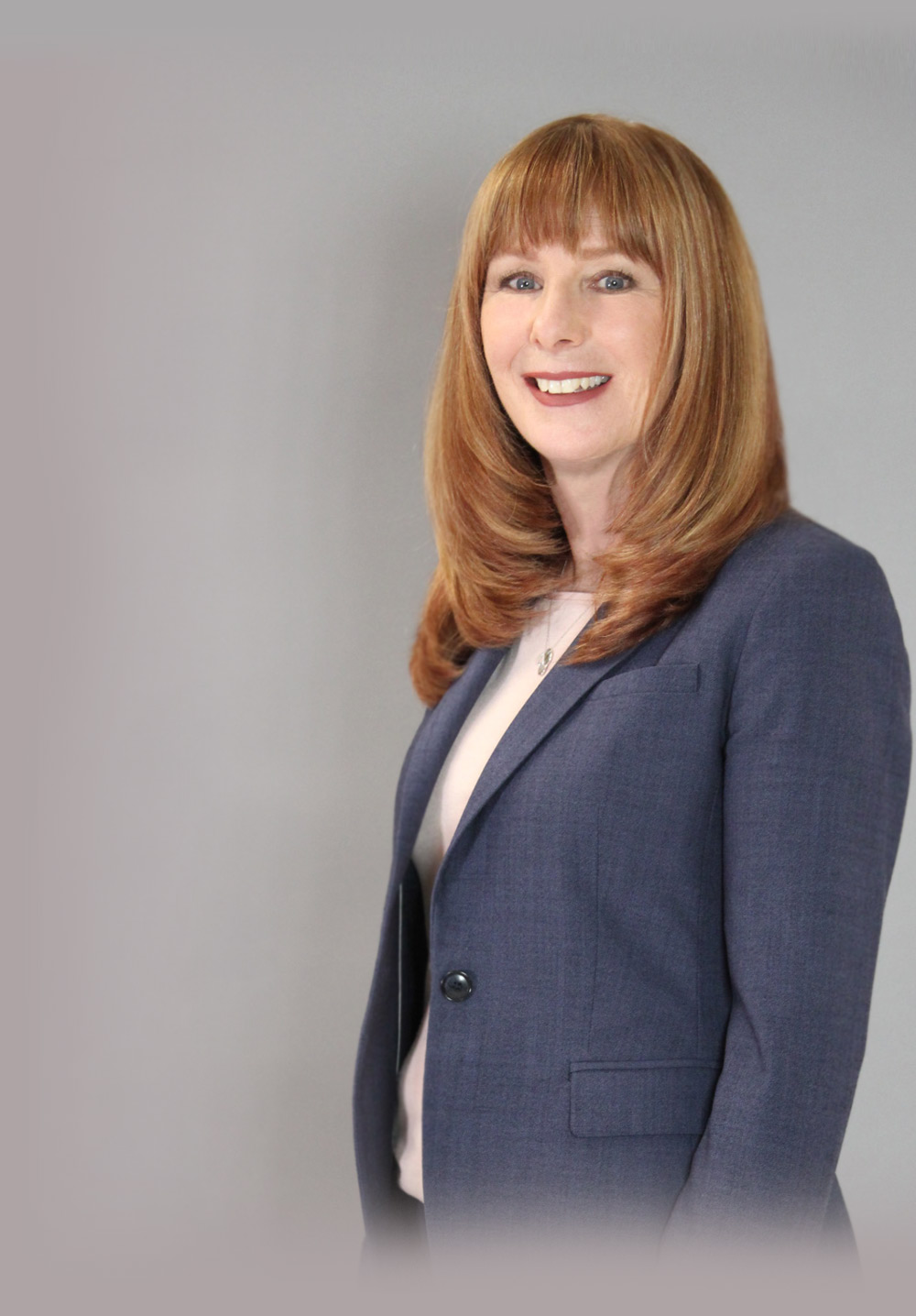
How long have you been a school board member and what inspired you to become one?
I have been a board member for eight years. I am a volunteer at heart who cannot say “no” when it comes to helping kids. I have been involved in PTA, school site councils, youth baseball and other organizations for years. A former school board member made me realize I could help our students on a higher level. I couldn’t say “no” to that.
What do you see as the role of public education?
I believe public education is the great equalizer and can change lives. Knowledge gained from a good education opens up possibilities for a child. My family was poor. I became the first in my family to go to college. My sisters followed suit, which inspired my mother to earn her nursing degree, which was her dream. Education changed our lives.
You spoke at the State Capitol on the negative impacts of the late start time bill, Senate Bill 328. How was that experience?
The experience was awe-inspiring. Walking into the hearing rooms, in front of a dais of state elected officials, was nerve racking. But it was so important for me to tell them our story of how the unintended consequences of the bill would hurt our district and students. I realized afterward that our legislators really need to hear our stories. I felt proud and humbled that I was asked to tell it.
Who was one of your favorite teachers and why?
My high school drama teacher, Doc Roberts. My family moved around a lot and by the time I reached high school, I had attended 13 different schools. As a result, I was shy. He pushed his students to take chances and created a “safe” environment for us to challenge ourselves. My self-esteem and self-confidence just exploded during my four years in his class.
What are some of the overlooked or underappreciated issues in rural districts like yours?
Geography, distance and weather make transportation really important in getting our students to school. However, transportation is considered a “choice” by the state in our decision to pay for it out of our LCFF funds. Transportation is not a choice but a necessity and should be fully funded. Spotty cell phone service and high-speed internet access are issues. Creating leadership stability is an issue because administrators will use our district as a “stepping stone” to higher salaries and a move to more urban areas. It’s a challenge for our students to easily access enrichment opportunities such as museums, summer enrichment programs, internships, larger pool of volunteer opportunities, SAT/ACT test prep classes, dual/concurrent enrollment in college classes and such. It’s a trek just to get to Target!
How important do you believe it is for board members to engage in advocacy?
As a board member, you can either sit back and “let” things happen to your district and students and fret over the unfairness of dealing with decisions out of your control, or you can do something and speak up. Make your local and state elected officials hear you. Fight for your students and tell their story and your district’s story, because only you can tell it. Maybe one little thing you say will have a huge impact.

during the COVID-19 pandemic
“This pandemic has made clear what board members and educators have known all along — our public schools are a vital component of what makes our society function,” CSBA CEO & Executive Director Vernon M. Billy said. “We need to invest in schools now more than ever. Board members, teachers, administrative and classified staff have shown strength, creativity and resilience from the beginning of this crisis. Let us remember that California’s schools stepped up to the plate and continued learning for the state’s students when schools were closed abruptly. And let’s provide the financial support they need to weather this storm and continue to build new systems and structures for learning that can carry through to a post-pandemic world.”





 he renewed focus — particularly on improving inadequate funding, inconsistent training and varying resources by district or county office — perhaps fortuitously arrives amid the economic devastation of the COVID-19 pandemic affecting countless families. “I think districts could very well find themselves at the end of this potentially serving more students who have been economically impacted,” said Tasminda Dhaliwal, a research associate in the USC Rossier School of Education’s Center on Education Policy, Equity and Governance and an expert on K-12 student homelessness.
he renewed focus — particularly on improving inadequate funding, inconsistent training and varying resources by district or county office — perhaps fortuitously arrives amid the economic devastation of the COVID-19 pandemic affecting countless families. “I think districts could very well find themselves at the end of this potentially serving more students who have been economically impacted,” said Tasminda Dhaliwal, a research associate in the USC Rossier School of Education’s Center on Education Policy, Equity and Governance and an expert on K-12 student homelessness.

While that scenario may sound like education officials going above and beyond the call of duty, in community schools throughout the state, addressing the needs of the whole child and their family is common or expected.
California Surgeon General

